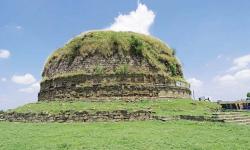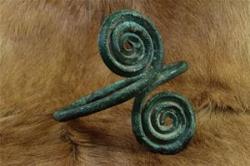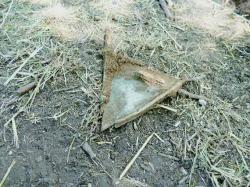INSTITUT SUPERIEUR D'ANTHROPOLOGIE
INSTITUTE OF ANTHROPOLOGY
ONLINE COURSES / COURS A DISTANCE
FALL TERM : OCTOBER 2015
REGISTER NOW
ROYAUME UNI –  Eastbourne - In the last 150 years approximately 200 bodies have been discovered in a site previously untouched for centuries. Now archaeologists hope to discover more through a new excavation project at a burial ground in Eastbourne. The ancient Ocklynge cemetery, established around 1,300 years ago in the 600 to mid-700s AD, lay undiscovered and continuously developed until residents began to discover its hidden secrets. The majority of the skeletons belonged to people under the age of 18, with the rest aged over 26 and the eldest 80, indicating that those who managed to survive into adulthood stood a good chance of living up to the age 40 – an average age which was reasonable in Britain at the time. Tall and well-built, with men reaching an average 1.76m - not dissimilar to the current average male height in the UK of 1.77m - they showed signs of early age osteoarthritis, indicating that hard manual labour was a common part of their lives. Nearly all of the individuals had a seafood-rich diet, suggesting that fishing was a major part of their lifestyle. Eastbourne Heritage Service is confident that at least the southern part of the cemetery was planned out and well organised, and that the graves would probably have been marked individually, as all of them came back with the same dating results. A ground penetrating radar survey of the area was carried out in March. But as the results were unclear, a more in-depth excavation is necessary to discover more about this ancient burial site.”
Eastbourne - In the last 150 years approximately 200 bodies have been discovered in a site previously untouched for centuries. Now archaeologists hope to discover more through a new excavation project at a burial ground in Eastbourne. The ancient Ocklynge cemetery, established around 1,300 years ago in the 600 to mid-700s AD, lay undiscovered and continuously developed until residents began to discover its hidden secrets. The majority of the skeletons belonged to people under the age of 18, with the rest aged over 26 and the eldest 80, indicating that those who managed to survive into adulthood stood a good chance of living up to the age 40 – an average age which was reasonable in Britain at the time. Tall and well-built, with men reaching an average 1.76m - not dissimilar to the current average male height in the UK of 1.77m - they showed signs of early age osteoarthritis, indicating that hard manual labour was a common part of their lives. Nearly all of the individuals had a seafood-rich diet, suggesting that fishing was a major part of their lifestyle. Eastbourne Heritage Service is confident that at least the southern part of the cemetery was planned out and well organised, and that the graves would probably have been marked individually, as all of them came back with the same dating results. A ground penetrating radar survey of the area was carried out in March. But as the results were unclear, a more in-depth excavation is necessary to discover more about this ancient burial site.”
http://www.culture24.org.uk/history-and-heritage/archaeology/art532482-archaeologists-plan-to-excavate-eastbourne-burial-site-of-hundreds-of-bodies
CHINE – Xuchang - Two fossilized bones of ancient Chinese man who lived some 100,000 years ago have been found in central China's Henan Province, the local institute of cultural relics and archaeology announced on Tuesday. It is the first time that archaeologists have found two complete fossilized bones of "Xuchang man" near Henan's Xuchang city. Both bones may belong to the same man. Two skulls were found in 2007, according to Li Zhanyang, leader of the archaeological group. More than 1,000 fossilized animals and stone implements were found at the same site. The research was jointly conducted by Henan institute of cultural relics and archaeology and the institute of vertebrate paleontology and paleoanthropology of the Chinese Academy of Sciences.
http://www.shanghaidaily.com/article/article_xinhua.aspx?id=293628
PAKISTAN –  Mankiala - The 3rd century BC Buddhist Stupa (a mound like structure typically containing the remains of Buddhist monks) in Mankiala village on the G.T. Road just beyond the Rawat bus stand is one such ancient ruin which has survived the test of time so far but is threatened by the chaotic urban development. The Department of Archaeology and Museums (DOAM) believes that the Mankiala Stupa and its monasteries are spread over an area of three miles. However, most of these remains are buried under a messy urban sprawl that has come up in the recent years. According to Ghafoor Lone of the DOAM, this religious establishment could be one of the significant stupas built by the Indian King Ashoka who is known for not just ruling over most of the Indian subcontinent but also converting to Buddhism. The Stupa of Dharmarajika in Taxila valley, enlisted as a world heritage site with Unesco, was the first Stupa built by Ashoka to bury the ashes of Buddha. According to the archaeologist, the Mankiala Stupa is also historically significant but neglect and encroachment are threatening it. A team of officials from the department were concerned when they visited the ancient remains a couple of weeks ago. The dilapidated historical ruin is threatened by encroachments; a small house, a flour mill and a bus stand have crept dangerously close to the site which is protected under the Antiquities Act 1975.
Mankiala - The 3rd century BC Buddhist Stupa (a mound like structure typically containing the remains of Buddhist monks) in Mankiala village on the G.T. Road just beyond the Rawat bus stand is one such ancient ruin which has survived the test of time so far but is threatened by the chaotic urban development. The Department of Archaeology and Museums (DOAM) believes that the Mankiala Stupa and its monasteries are spread over an area of three miles. However, most of these remains are buried under a messy urban sprawl that has come up in the recent years. According to Ghafoor Lone of the DOAM, this religious establishment could be one of the significant stupas built by the Indian King Ashoka who is known for not just ruling over most of the Indian subcontinent but also converting to Buddhism. The Stupa of Dharmarajika in Taxila valley, enlisted as a world heritage site with Unesco, was the first Stupa built by Ashoka to bury the ashes of Buddha. According to the archaeologist, the Mankiala Stupa is also historically significant but neglect and encroachment are threatening it. A team of officials from the department were concerned when they visited the ancient remains a couple of weeks ago. The dilapidated historical ruin is threatened by encroachments; a small house, a flour mill and a bus stand have crept dangerously close to the site which is protected under the Antiquities Act 1975.
http://www.dawn.com/news/1195443/buddhist-stupa-near-rawat-threatened-by-encroachments
POLOGNE –  Sandomierz - A unique monument has been donated to the archaeological collections of the District Museum in Sandomierz by an accidental finder. The arm ring made of bronze is more than 3 thousand years old. According to the curators, the style and form of the object and its ornament can be attributed to the Trzciniec culture community and dated to the years around 1300-1100 BC. In the Sandomierz Upland such finds are extremely rare, presumably coming from manufacturers in Silesia and Wielkopolska, but scientists do not exclude the local production of such items. Archaeologists regret that the ornament from Jasice is devoid of context - we do not know exactly where it came from and how it ended up in the scrap yard. They assume, however, that it had been discovered in the area. Not only the origin of the artefact is enigmatic. "We have little information on how these ornaments were worn, because they usually are known as treasure or standalone finds. Only a grave discovery could clarify this matter" - added Bajka. Archaeologists speculate that these ornaments were worn by both men and women. They could be worn on the shoulder or - as indicated by the grave discoveries in Germany, where similar ornaments have been found on the bones of the lower leg - on the leg.
Sandomierz - A unique monument has been donated to the archaeological collections of the District Museum in Sandomierz by an accidental finder. The arm ring made of bronze is more than 3 thousand years old. According to the curators, the style and form of the object and its ornament can be attributed to the Trzciniec culture community and dated to the years around 1300-1100 BC. In the Sandomierz Upland such finds are extremely rare, presumably coming from manufacturers in Silesia and Wielkopolska, but scientists do not exclude the local production of such items. Archaeologists regret that the ornament from Jasice is devoid of context - we do not know exactly where it came from and how it ended up in the scrap yard. They assume, however, that it had been discovered in the area. Not only the origin of the artefact is enigmatic. "We have little information on how these ornaments were worn, because they usually are known as treasure or standalone finds. Only a grave discovery could clarify this matter" - added Bajka. Archaeologists speculate that these ornaments were worn by both men and women. They could be worn on the shoulder or - as indicated by the grave discoveries in Germany, where similar ornaments have been found on the bones of the lower leg - on the leg.
http://scienceinpoland.pap.pl/en/news/news,405795,from-scrap-heap-to-museum.html
ROYAUME UNI –  Enfield- Archaeologists have discovered an incredibly rare find which could transform our understanding about the history of Enfield. Members of the Enfield Archaeology Society made the surprise discovery of a triangular window pane dating back to the Tudor Era, found at Forty Hall Estate. The preserved window pane was found with an original lead ’came’ (frame around the panel) held intact, making it an exceptionally rare item. It is now due for examinations to test whether the glass is painted, before finding a permanent home in Enfield Museum.
Enfield- Archaeologists have discovered an incredibly rare find which could transform our understanding about the history of Enfield. Members of the Enfield Archaeology Society made the surprise discovery of a triangular window pane dating back to the Tudor Era, found at Forty Hall Estate. The preserved window pane was found with an original lead ’came’ (frame around the panel) held intact, making it an exceptionally rare item. It is now due for examinations to test whether the glass is painted, before finding a permanent home in Enfield Museum.
http://www.enfield-today.co.uk/article.cfm?id=2076&headline=Archaeologists+make+rare+discovery+at+Forty+Hall&year=2015
GRECE –  Megalo Kavouri beach - An ancient roadway dating back to the 4th Century BC was discovered by archaeologists at Megalo Kavouri beach in a southern suburb, Vouliagmeni, the ministry of Culture said on Monday. The road, paved with small stones placed close to one another, varies in width from 1.90 metres to 6.10 metres and is a length of about 300 metres. It is delineated by retaining walls on either side that also serve to keep the pavement stable, as the earth underneath is soft and sandy. At its widest point, and resting on a retaining wall, were found the foundations of a rectangular building with a floor that resembles the road, leading archaeologists to believe it was constructed at the same time as the road. Both were in use throughout the 4th century BC, as evidence of pottery and coins shows. The road appears to have linked the ancient part of the city with the beach, and to have connected to a greater road network, parts of which have been discovered at several sites along the coast. The network included a greater road linking Athens with Sounion, the southernmost point of the Attica peninsula, and a road that followed the coast from Faliro to Voula, southwest to southeast of Athens. Excavations began within a general NSRF-funded project to improve the area of Megalo Kavouri, and were later funded by Greek shipowner Athanassios Martinos, whose support allowed the completion of an archaeological park at Megalo Kavouri beach.
Megalo Kavouri beach - An ancient roadway dating back to the 4th Century BC was discovered by archaeologists at Megalo Kavouri beach in a southern suburb, Vouliagmeni, the ministry of Culture said on Monday. The road, paved with small stones placed close to one another, varies in width from 1.90 metres to 6.10 metres and is a length of about 300 metres. It is delineated by retaining walls on either side that also serve to keep the pavement stable, as the earth underneath is soft and sandy. At its widest point, and resting on a retaining wall, were found the foundations of a rectangular building with a floor that resembles the road, leading archaeologists to believe it was constructed at the same time as the road. Both were in use throughout the 4th century BC, as evidence of pottery and coins shows. The road appears to have linked the ancient part of the city with the beach, and to have connected to a greater road network, parts of which have been discovered at several sites along the coast. The network included a greater road linking Athens with Sounion, the southernmost point of the Attica peninsula, and a road that followed the coast from Faliro to Voula, southwest to southeast of Athens. Excavations began within a general NSRF-funded project to improve the area of Megalo Kavouri, and were later funded by Greek shipowner Athanassios Martinos, whose support allowed the completion of an archaeological park at Megalo Kavouri beach.
http://www.sigmalive.com/en/news/greece/132422/ancient-roadway-linking-to-whole-city-discovered-in-athens?#.dpuf